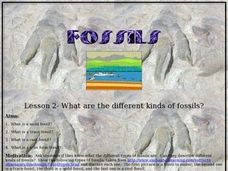Curated OER
How I Use Water
Beginning with a brief anticipatory set on how water is commonly used, this presentation evolves into a well planned lesson on the water cycle. Students will discuss vocabulary, label the parts of the water cycle, locate where water is...
Curated OER
Water Speed and Erosion
Fourth graders investigate the process of water erosion. They observe the roots of a plant and discuss the concept of erosion. Next, in small groups they conduct an experiment to observe how water erodes soil on a stream table, and...
Curated OER
Water Cycle (Grades 2-4)
Students demonstrate their understanding of the water cycle and how it effects the environment by graphically depicting and describing the water cycle.
Curated OER
Exploring How Rocks Are Formed
These lessons produced by the Illinois State Museum are quite good. In this one, third and fourth graders are introduced to the three basic types of rocks: igneous, sedimentary, and metamorphic. They perform activities which help them...
NASA
S’COOL Cloud Identification Chart
If you've ever wondered why clouds sometimes look so different, look no further than a classroom poster about cloud identification. It features pictures of clouds at high, mid, and low levels of altitude, as well as the name of each and...
Curated OER
Pollution
Young ecologists investigate some of the many ways that human activities adversely affect the environment. After identifying the main types of pollution (air, water, soil), 3rd graders fill in a Venn Diagram by pasting cut-out pictures...
Curated OER
Life in a Drop of Pond Water
Students investigate living creatures that inhabit a pond and explore how various organisms satisfy their needs within their environments. In this life in a drop of pond water lesson, students examine microorganisms under magnification....
Curated OER
The Water Cycle
In this water cycle worksheet, students read an informational passage, observe a labeled diagram of the transpiration water cycle, and answer comprehension questions. Students answer seven multiple choice questions and write a story from...
Curated OER
Kindness Graffiti Wall
Students discuss acts of kindness. In this character education lesson, students use a large sheet of poster paper, tempera paint, and markers to create a graffiti wall. Students write down their ideas of kindness and share their wall...
Purdue University
Design of an Earthen Dam for a Lafayette Neighborhood
How do dams support bodies of water? Scholars engage in a hands-on STEM activity where they design, build, and test dams to learn about bodies of water and how humans use natural resources. They learn how criteria and constraints affect...
Curated OER
Miniature Water Cycles
Fourth graders create a biome of their choosing in a terrarium. Terrariums are observed and results recorded daily for 2 weeks. They observe/record changes in the water within their terrarium and use the data to write sentences...
Curated OER
Water Cycle
Students investigate, develop inferences, and differentiate between different elements of the water cycle. They investigate the observable characteristics of evaporation and condensation over specific time periods
Curated OER
Water 1: Water and Ice
Young scholars explore the water cycle. In this water cycle lesson, students complete a hands-on activity that replicates the water cycle. Young scholars record their observations.
Curated OER
A Little Chemistry
The molecular properties of water are the focus of this chemistry-based assignment. Multiple-choice, true-or-false, matching, and fill-in-the-chart style questions query assignees about the forces that hold the water molecule together,...
Curated OER
Exploring How Rocks Are Formed
Students examine the three types of rocks. They discover the processes that occur so each type of rock can be formed. They participate in activities to help them see how rocks are formed.
Chymist
The Solubility of a Salt in Water at Various Temperatures
An educational instructional activity allows young chemists to test the solubility of different types of salt at various temperatures. Groups create a graph using data from unsaturated, saturated, and supersaturated solutions.
Curated OER
What are the Different Kinds of Fossils?
Students examine different types of fossils. In this fossil lesson plan, students investigate the attributes of mold fossils, trace fossils, cast fossils, and true form fossils. Students create their own fossil samples.
Pennsylvania Department of Education
Wind and Water Wheels
Learners identify wind and water as natural resources that create energy. In this natural resources and energy use lesson, students work in groups to construct a pinwheel, then explore the effects of wind and water on the pinwheel....
NOAA
It All Runs Downhill
Examine how pollution makes its way into an ocean with help from a model watershed. Scholars use household items to recreate a mini-watershed, equipped with pollutants, that when mixed with rain drain into a model's body of water. After...
Polar Trec
Nature's Density Column
Nature provides density columns in the polar regions that provides food for many animals. Young scientists build their own density columns with water in order to answer analysis questions. Through a slideshow presentation, scholars...
Forest Foundation
Forest Watersheds
Where does the water we use come from? To understand the concept of a watershed, class members study the water cycle and then engage in an activity that simulates a watershed.
Curated OER
What Is the Matter with Water?
Second graders observe matter in all 3 states : liquid, solid and gas, in an ice cream soda. In teams, they are given ice and teams compete to be the first to melt their ice. Winner gets the ice cream soda. They draw examples of 3 states...
Curated OER
Making "Cents" of Surface Tension
Students explore the unique behaviors of water. They investigate surface tension using water drops on a penny and pennies dropped in a cup.
Curated OER
Surface Tension and Bubbles
Learners investigate surface tension and bubbles. In this scientific inquiry lesson plan, students explore how the surface tension of water is able to support tiny objects that actually weigh more than the water as they collect date by...

























